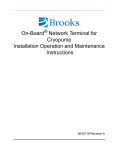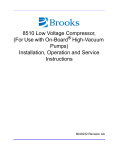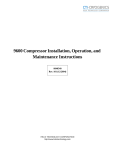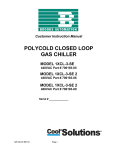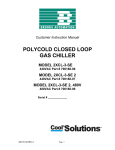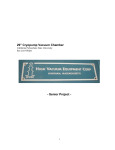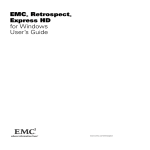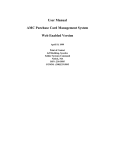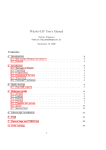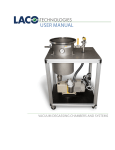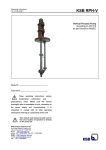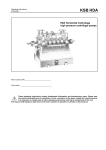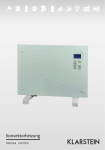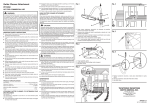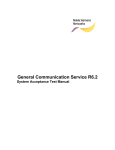Download My Document - Brooks Automation
Transcript
Polycold® Portable Cryocooler Model P-102 Operator and Installation Manual Part Number 174320 Brooks Automation. Accelerating Innovation. Information provided within this document is subject to change without notice, and although believed to be accurate, Brooks Automation assumes no responsibility for any errors, omissions, or inaccuracies. AcuLigner™, Align™, AquaTran™, AutoTeach™, ATR™, AXM™, Basic Blue™, BiSymmetrik™, CenterSmart™, Cool Solutions™, Crate to Operate™, e-RMA™, e-Spares™, e-Volution™, FastRegen™, FIXLOAD™, FrogLeg™, InLigner™, InCooler™, Interface™, Jet Engine™, LowProfile™, M2 Nano™, MiniIon™, PASIV™, PowerPak™, PerformanceBlue™, PowerPak™, PowerTools™, QuadraFly™, Radius™, Radient™, Radient Express™, Reliance™, Reliance ATR™, RetroEase™, SCARA™, SmartPM™, SPOTLevel™, Synetics™, The New Pathway to Productivity™, Time Optimized Trajectory™, Time Optimal Trajectory™, Time Optimized Path™, TopCooler™, TopLigner™, Ultimate Blue™, VAC-407™, VacuTran™, Vacuum Quality Monitor™, VQM™, Vacuum Quality Index™, VQI™, and the Brooks logo are trademarks of Brooks Automation, Inc. AcuTran®, AquaTrap®, Conductron®, Convectron®, the Cool Solutions logo, Cryodyne®, Cryotiger®, CryoTorr®, Fusion®, GOLDLink®, Granville-Phillips®, Guardian®, GUTS®, Helix®, Jet®, Leapfrog®,MagnaTran®, MapTrak®, Marathon®, Marathon 2®, Marathon Express®, Micro-Ion®, MiniConvectron®, On-Board®, Polycold®, Razor®, Simplicity Solutions®, the Simplicity Solutions logo, Stabil-Ion®, TrueBlue®, TurboPlus®, Vision®, Zaris®, and the Brooks Automation logo are registereU.S. trademarks of Brooks Automation, Inc. All other trademarks are properties of their respective owners. © 2014 Brooks Automation, Inc. All Rights Reserved. The information included in this manual is Proprietary Information of Brooks Automation and is provided for the use of Brooks Automation customers only and cannot be used for distribution, reproduction, or sale without the express written permission of Brooks Automation. This information may be incorporated into the user’s doumentation, however any changes made by the user to this information is the responsibility of the user. Corporate Headquarters 15 Elizabeth Drive Chelmsford, MA 01824 U.S.A. For Technical Support: Location North America Europe Japan China Taiwan Korea Singapore GUTS® Contact Number +1-800-FOR-GUTS (1-800-367-4887) +1-978-262-2900 +49-1804-CALL-GUTS (+49-1804-2255-4887) +81-45-477-5980 +86-21-5131-7066 +886-3-5525225 +82-31-288-2500 +65-6464-1481 Visit us online: www.brooks.com September, 16, 2014 Part Number: 174320 Revision D This technology is subject to United States export Administration Regulations and authorized to the destination only; diversion contrary to U.S. law is prohibited. Original manual printed in English. Printed in the U.S.A. Brooks Automation. Accelerating Innovation. Preface Regulatory Compliance Limited Warranty Limitations 1. Introduction System Summary Basic Principles of Operating for the Polycold Refrigeration Cycle System Components Specifications of the System Physical Specifications Operating Specifications Moving the Product Safety Alerts, Equipment Alerts, and Add Info Formats Alert Signal Word Definition Alert Colors Alert Example Use of Notes Safety and Equipment Considerations Equipment Guidelines Personnel Safety Guidelines Equipment Safety Guidelines Safety Labels and Safety Label Identification Labels Label Identification and Location Mechanical Hazards Electrical Hazards Environmental Hazards Noise Vibration Recycling and Disposal Information Refrigerant Disposal of the P-102 When Decommissioning Thermal Hazard 2. Installation Installation Requirements Power Specifications Site Requirements Service and Exclusion Zones Unpacking and Inspection Unpacking and Moving Instructions ii v v vi vii 1 1 1 3 3 3 4 4 5 5 5 6 6 7 7 7 8 9 9 9 11 12 12 12 12 13 13 13 13 15 15 15 15 16 17 17 Unpacking the P-102 Moving the P-102 18 19 Starting Up the P-102 19 3. Operation External Controls and Indicators Powering Up the P-102 Defrosting the P-102 Compressor and Condenser Fan Motors Safe Shut Down Shutting the P-102 Down For Maintenance 4. Preventive Maintenance P-102 Maintenance Parts Preventive Maintenance Schedule and Procedures Cleaning the Air Cooled Condenser Cleaning the Air-intake Grill Cleaning the Cold Probe 5. Troubleshooting Troubleshooting Chart 6. Parts and Service Contacting Brooks Automation Technical Support Polycold Customer Support Information For Emergency after Hours Support Packing and Shipping Instructions Packing and Shipping Procedure Appendix Appendix A: Material Safety Sheets 21 21 22 23 23 23 24 25 25 25 25 26 27 28 29 29 32 32 32 33 33 34 I I Preface Regulatory Compliance The Polycold Cryocooler P-102 meets the requirements of the European Union’s Machinery Directive (2006/42/EC). The Low Voltage Directive (2006/95/EC) and the EMC Directive (2004/108/EC), Brooks Automation has issued a Declaration of Conformity and the Polycold Cryocooler P-102 has a CE mark affixed. A Declaration of Conformity was sent with your Polycold Cryocooler. If you no longer have this document, please contact [email protected]. Below is a sample of a Declaration of Conformity. Limited Warranty Limitations This product is intended for use by industrial customers and should be serviced only by Brooks or Brooks trained representatives. The service manuals and related materials are provided in English at no charge and are intended for use by experienced technicians. It is the responsibility of the user to obtain and assure the accuracy of any needed translations of manuals. If you require assistance please contact Brooks service department. Contact information can be found at www.brooks.com. 1. Introduction System Summary User Manual 1. Introduction System Summary The Polcold® P-102 Portable Cryocooler provides compact, portable, and easy-to use alternatives to liquid nitrogen used in small vacuum systems. These cryogenerators use refrigerants in a closed loop system. The refrigerants are: l l l l Safe Non-flammable Non-toxic HCFC-free This means there is no moving of heavy liquid nitrogen dewars. Also, there is no running out of cryogen causing downtime. Installation is quick and easy. Either a cold probe is inserted into a housing or a chevron baffle is installed between a diffusion pump and a high vacuum valve. The cold probes and chevron baffles are referred to as cryosurfaces. These are part of the refrigerant line. Removing them causes a loss of refrigerant. Cold trapping applications include: l l l Helium mass spectrometer leak detectors Chevron baffles for diffusion pumps up to 6 inches (160 mm) in diameter Vapor trapping cold probes that protect mechanical pumps on small vacuum systems. Basic Principles of Operating for the Polycold Refrigeration Cycle This cooling process is an auto cascade refrigeration system. A patented mixture of non-flammable and safe CFC-free and HCFC-free refrigerants is compressed and circulated by a compressor. In a simplified version, the Polycold refrigeration cycle comprises: 1. Compressing a mixture of refrigerants 2. Partially condensing the higher boiling fractions in an air-cooled condenser 1-1 Brooks Automation 1. Introduction User Manual Basic Principles of Operating for the Polycold Refrigeration Cycle 3. Separating and throttling the liquid condensate produces cooling that condenses the remaining vapors in a special heat exchanger. In the process of providing cooling in the Cryocooler, this mixture is partially evaporated. 4. Throttling this latter condensate and feeding the cryocoil to produce cooling at very low temperatures 5. Passing the refrigerant leaving the cooling coil back through the heat exchanger to the compressor. Operating pressures and compressor temperatures are similar to those in air-conditioning systems. The compressor lubricating oil circulates with the discharge vapors. The oil promptly returns to the compressor without reaching the very low temperature portions of the system. This eliminates the common problems of oil plugging in evaporators and expansion devices too often seen in low temperature systems. The mixed refrigerant charge is hermetically sealed into the system. Normally neither the refrigerant nor the compressor lubricating oil requires replacement or recharging. In this unit, there is a series of intermediate special heat exchangers called cascade condensers. These are located between the air-cooled condenser and the final cooling coil (cold probe). There are multiple stages of partial condensation, phase separation, condensate throttling, and intermediate cooling. In addition, the system has a suction-side refrigerant vapor expansion tank and a dischargeside receive tank to limit start-up discharge pressures. Accelerating Innovation 1-2 1. Introduction System Components User Manual System Components Figure 1-1: P-102 Croyocooler Specifications of the System Physical Specifications NOTE: All specifications are for the standard product configuration, specifications can vary for customized configurations. 1-3 Brooks Automation 1. Introduction User Manual Specifications of the System Table 1-1: Physical Specifications Physical Property Value Dimensions: Width Depth Height (From floor, including casters, to top of frame) 445 mm (17.5 inches) 521 mm (20.5 inches) 845 mm (33.25 inches) Weight, with lines: 82 Kg (180 lb) Flex line length: 1778/1752.6 mm (70/69 in) (Standard 5 foot flex line) Cooling: Forced air Temperature at Heat Load: -135° C with no load. And -110° C with 120W load Initial cool down Time: 1.5 hr Baffles: Chevron Baffles, Opaque, low-profile, spool piece style l l l l Cold Probes l 4-inch cold bath, nominal 4-inch chevron baffle 6-inch cold bath, nominal 6-inch chevron baffle Trap housing for mechanical pump traps Cold probe, stainless steel, “Easy Clean” Cold probe, nickel plated copper with coil on exterior of mandrel Operating Specifications Table 1-2: Operation Specifications Property Specification Room temperature to -110° C (-166° F) in about 45 minutes Ramp Time to Temperature: (No applied load) Room temperature to -125° C (-193° F) in about 80 minutes Operating Temperature Ambient room temperature of 15 - 30° C (59 - 86° F) 50Hz Operation Temperature will be approximately 5°C Warmer Noise (maximum) 69 db(A) at 1m from the unit Moving the Product The Polycold Cryocooler P-102 rolls across smooth floors on four casters. Be sure there are no objects in the path as you roll the unit. Rolling across objects or wiring creates a tip hazard. Rolling up or down ramps also creates a tip hazard. Accelerating Innovation 1-4 1. Introduction Safety Alerts, Equipment Alerts, and Add Info Formats User Manual The casters have no locking device. Use proper care when moving the P-102. Position the Cryocooler in a way it can not accidently be moved to an improper location. Safety Alerts, Equipment Alerts, and Add Info Formats This manual and the Polycold Portable Cryocooler P-102 uses the following conventions for notifying the user about personal or equipment safety. This chapter shows the alerts used on the equipment and the locations of the alerts on the equipment. Alert Signal Word Definition The following are definition of the four levels of alerts as defined by ANSI and SEMI. The most serious is listed first. DANGER, WARNING, and CAUTION are defined by the level of personal injury. NOTICE only applies to possible equipment or material damage. Table 1-3: Signal Word Definitions Signal Word Definition DANGER Indicates a hazardous situation which, if not avoided, will result in death or serious injury. This signal word is to be limited to the most extreme situations. WARNING Indicates a hazardous situation which, if not avoided, could result in death or serious injury. CAUTION Indicates a hazardous situation which, if not avoided, may result in minor or moderate injury. NOTICE Indicates a situation which, if not avoided, could result in property damage. Alert Colors Table 1-4: Colors of Signal Word Panels Signal Word DANGER 1-5 Color of Signal Word Panels and Backgrounds Background: Red Signal Word: White General Icon in the Signal Word Frame: Yellow with Black frame and exclamation point Brooks Automation 1. Introduction User Manual Safety Alerts, Equipment Alerts, and Add Info Formats Signal Word Color of Signal Word Panels and Backgrounds WARNING Signal Word: Black Background: Orange General Icon in the Signal Word Frame: Yellow with Black frame and exclamation point CAUTION Signal Word: Black Background: Yellow General Icon in the Signal Word Frame: Yellow with Black frame and exclamation point NOTICE Signal Word: White Background: Blue The signal word area of the alert does not contain an icon. The text area may include icons that are not intended for personal safety. Alert Example The following is an example of a WARNING alert. Use of Notes Notes are used throughout the manual to make the user is aware of additional information or to explain important information. Information in notes is not related to human or equipment safety. A note does not use icons. The following is an example of a Note. Accelerating Innovation 1-6 1. Introduction Safety and Equipment Considerations User Manual NOTE: Save all shipping materials for possible future use. If you return the P-102 to Polycold Systems for service or ship it to another location, the original shipping crate must be used. Safety and Equipment Considerations These the following are basic guidelines. If the facility additional safety guidelines, follow those as well. Also follow all national and international safety codes that apply. Equipment Guidelines The following guidelines aid in the use and service of the Polycold Cryocooler P-102. l l l l l l Brooks Automation Technical Support issues a Technical Support Bulletin (TSB) to notify the owners of record of any field retrofits. Contact Brooks Automation Customer Support for information about repair and maintenance service policies, both during the production of the product and after production is discontinued. Any user caused damage during the assembly of the product into their equipment is the user’s responsibility. Polycold System’s responsibility for work performed by Polycold/Brooks authorized technicians or for equipment transported or resold by the owner of record is determined on a case-by-case basis by Brooks Automation Technical Support. Any parts being returned to Polycold are to be packaged according to the instructions provided with the replacement part. Packing instructions for shipping the Cryocooler P-102 are provided. Only qualified, properly trained persons should perform any procedures on the product. Damage that results from not properly performing a procedure or not following cautions and notices is not covered under warranty or service agreements. Personnel Safety Guidelines The Brooks Automation, Inc. Polycold Systems P-102 may provide several direct safety hazards to personnel if not properly installed or operated. l Persons operating the product should be properly trained. l Possible injury can result from the automatic operation of the product if the covers are removed. l Wear the following safety equipment according to the manufacturer’s instructions before you to install or service the P-102: l l l l l 1-7 Eye protection Gloves Observe the facility guidelines pertaining to loose clothing while working around or operating the P-102. Read and understand the Material Safety Data Sheets (MSDS) for each chemical used with the product. These individual sheets are provided in "Material Safety Sheets" on page I. It may be recommended that the use of hazardous materials, such as cleaning fluids, be used during routine maintenance procedures. Read and understand the facility’s MSDS (provided by the manufacturer) for each substance. Brooks Automation 1. Introduction User Manual l Safety and Equipment Considerations Ensure the product has been properly decontaminated before performing any service. Following the facilities’ decontamination procedures. Follow all facility and regulatory procedures for the disposal of any hazardous materials. l Ergonomic hazards may exist when moving the P-102. l Know the locations of Hazardous points on the P-102. WARNING THERMAL HAZARD Do not come in contact with the probe or baffles while they are cold. Frost bite or other contact could cause personal injury. Wait at least 90 minutes after the P-102 is turned off before allowing the probe or baffles to touch your body. The probe is to be at +10° C (50° F) before any person touches the probe. l l The probe is to be at +10° C (50° F) before any person touches the probe. When removing the probe from the vacuum housing protect yourself from contact with the cold probe when handling. Allow the cold probe to warm up for at least 90 minutes by which time it should be at +10° C (50° F). If signs of frost are still evidenced, then wait until all signs of frost are gone. If you must handle the probe before then, use appropriate personal protective equipment needed to protect against frostbite hazard. Equipment Safety Guidelines The following safety considerations aid in the placement and use of the Cryocooler. down the equipment during installation as needed. l The product is not provided with an Emergency Off (EMO) circuit. The user is accountable for the EMO circuit. l Do not place the product’s electrical connection or cold head line where they could cause a trip hazard. l Do not place the product in a location where it may be subject to physical damage. l Ensure that all power connections to the product are properly grounded. l Ensure that the product receives proper air flow for cooling. l Do not remove safety labels or equipment identification labels. l Turn OFF power before inserting or removing power cables. l Be aware of the hazardous points of the product as described in this chapter. l Use of the P-102 for any purpose other than as a cryocooler is not recommended and may cause damage to the product or the equipment to which it is connected. l Always operate the Cryocooler P-102 with the protective covers in place. l Do not install or operate the product if it has been dropped, damaged, or is malfunctioning. l Do not immerse cables or connectors in liquid. l Keep cables and connectors away from heated surfaces. l Do not modify the connectors or ports. Accelerating Innovation 1-8 1. Introduction Safety Labels and Safety Label Identification User Manual Safety Labels and Safety Label Identification Labels Safety labels and identification labels are placed on the Cryocooler P-102. These labels provide information for operators and service personnel to identify hazards. Some labels inform the user about the product. This section describes each label and identifies its location. Safety labels give instructions on how to avoid the hazard. Label Identification and Location Table 1-5 lists the labels that are affixed to the P-102. These labels alert personnel to hazards on or within the product. They also provide information about the product. Hazard: Mechanical Motion Qty: 2 Location: One on the fan shroud, half way up the side. One on the base plate on the side of the fan that is not shrouded. Hazard Type: CAUTION Possible Injuries: Damage to fingers How to avoid the hazard: Keep hands away from the fan. Hazard: Electrical Hazardous Voltage Qty: 1 Location: Panel in front of where the terminal block mounts inisde the P-102 Hazard Type: WARNING Possible Injuries: Electrical Shock or Burn How to avoid the hazard: Lockout/Tagout before servicing Hazard Type: Electrical High Voltage Qty: 2 Location: One on the compressor electrical box cover. One on the upper corner of the right side cover within which the terminal strip is mounted. Hazard Type: WARNING Possible Injuries: Electrical Shock or Burn How to avoid the hazard: Lockout/Tagout before Servicing. Servicing by qualified personnel Serial Label Qty: 1 Location: Lower right corner of upper real panel. Hazard Type: N/A Possible Injuries: N/A How to avoid the hazard: N/A Figure 1-2 shows the location of each label. To replace a lost or damaged label call Brooks Automation Technical Support. 1-9 Brooks Automation 1. Introduction User Manual Safety Labels and Safety Label Identification Figure 1-2: Locations of Labels on the P-102 Accelerating Innovation 1-10 1. Introduction Mechanical Hazards User Manual Mechanical Hazards The Polycold P-102 is a mechanical device. The P-102 contains a fan to air cool the condenser. Do not operate the P-102 without the protective covers. NOTE: Only persons with the proper training are to service or operate the product. Use Safety glasses and gloves when working on or near the P-102. WARNING Whenever power is applied the fan automatically turns on. There are no obstruction sensors and movement could result in personal injury. Do not operate the P-102 without the protective covers in place. CAUTION Heavy Object Hazard The Product weighs 82 kg (180 lb). Do not attempt to lift the P-102 without a forklift. Roll the P-102 across smooth floors. CAUTION Tip Hazard Tip hazard exists when moving the P-102 up or down a ramp. Be sure to prevent the P-102 from tipping when using a ramp. 1-11 Brooks Automation 1. Introduction User Manual Electrical Hazards CAUTION Trip Hazard Trip hazard exists if the power cord is not routed to in a way to cause a trip hazard. Route the cord in an area where there is no travel. Electrical Hazards The Brooks Automation, Inc., Polycold Systems P-102 is a high voltage device. At maximum load the product is capable of drawing close to 11.5 Amps at 200 - 230 VAC VDC. Maximum power consumption @ rated load for this product is 1620 watts. The minimum overcurrent ratings for disconnects requires a user installed 230 VAC, 20 A, minimum SCCR rating of 10 KIAC. The proper precautions for operating and servicing electrical equipment must be observed. WARNING Electrical Hazard The P-102 is a high voltage device. Turn off power and perform Lockout/Tagout before servicing. Improper electrical connection and connection to an improper electrical supply can cause electrical hazards. Improper handling of the power source or connecting devices can cause electrical shock or burns. These can result in serious injury or death or cause an equipment fire and damage to the equipment. Always provide the product with the proper electrical code compliant connections. Environmental Hazards Noise The Brooks Automation Product provides no direct noise hazard. Vibration The Brooks Automation Product provides no direct vibration hazard. Any vibrations produced are minimal and cause no hazardous conditions. Accelerating Innovation 1-12 1. Introduction Recycling and Disposal Information User Manual Recycling and Disposal Information The Brooks Automation Product contains refrigerant that may requires special handling for disposal or recycling. Refrigerant A qualified refrigeration technician is needed to remove the refrigerant from the P-102. Follow all facility and regulatory procedures for the disposal of hazardous materials. Disposal of the P-102 When Decommissioning Follow all facility and regulatory procedures for the disposal of hazardous materials. WARNING CHEMICAL HAZARD Whenever any cleaning fluid is used during service of the P-102, the facility’s environmental procedures must be followed regarding the storage, handling, and disposal of that fluid. Thermal Hazard The condenser and compressor inside the P-102 become hot during operation. Wait 90 minutes after you perform Lockout/Tagout according to the facility procedures before removing any covers. WARNING THERMAL HAZARD (hot) Hot surfaces can cause burns and personal injury. Do not operate the P-102 without all covers in place. Wait 90 minutes after performing Lockout/Tagout according to the facilities procedure before removing any cover. The probe is to be at +10° C (50° F) before any person touches the probe. When removing the probe from the vacuum housing protect yourself from contact with the cold probe when handling. Allow the cold probe to warm up for at least 90 minutes by which time it should be at +10° C (50° F). If signs of frost are still evidenced, then wait until all signs of frost are gone. If you must handle the probe before then, use appropriate personal protective equipment needed to protect against frostbite hazard. 1-13 Brooks Automation 1. Introduction User Manual Thermal Hazard WARNING THERMAL HAZARD (cold) Do not come in contact with the probe or baffles while they are cold. Frost bite or other contact could cause personal injury. Wait at least 90 minutes after the P-102 is turned off before allowing the probe or baffles to touch your body. Reference Document: ISO 13732-3, Ergonomics of the thermal environment - Methods for the assessment of human responses to contact with surfaces; Part 3: Cold Surfaces Accelerating Innovation 1-14 2. Installation Installation Requirements User Manual 2. Installation Installation Requirements The following information contains information you need for installation of the P-102. Power Specifications The following table includes electrical specification for the P-102. Table 2-1: Electrical Specifications Electrical Properties Specifications Voltage/Frequency/Phase (±10%) 200 VAC @ 50 Hz - Single Phase 208-230 VAC @60 Hz - Single Phase Inrush Current 41 Amps (locked rotor amps) Maximum Continuous Current 11.5 Amps Maximum Rated Load Amps 7.5 Amps Overvoltage Category Category II Disconnect Device The disconnect device is customer supplied. It should be rated for minimum 10 KAIC. The P-102 is not provided with a circuit breaker or a disconnect device. Site Requirements The following table lists Site Specifications. 2-15 Brooks Automation 2. Installation User Manual Installation Requirements Table 2-2: Environmental Specifications Environmental Factors Specifications Temperature: Ambient Air During Operation 15 – 30° C (59 – 86° F) Shipping -20 – +49° (-4 – +120° F) Storage A room temperature of 4 – 49° C (40 – 120° F), non condensing 50Hz Operation Temperature will be approximately 5°C Warmer. Relative Humidity 20 – 80%, non-condensing relative humidity Lighting Standard lighting is sufficient for proper operation. Maintenance may require a service lamp or flashlight. Transport The P-102 must remain in a vertical position. Install Location Be sure to allow 18 inches in front of and to the rear of the P-102. Well ventilated area greater than 2200 ft3 Above ground Service Access The P-102 requires adequate space for service access and for proper ventilation. Typical service space required is shown in Figure 2-1 . Allow 36 inches to the left and right sides of the P-102 for service areas. Ground Clearance 1 7/8 inches Rolling Provision Four casters Lifting Provision Use a fork lift Hold-Down Provision None. Determine if the P-102 is being used in an earthquake prone area. If so, the customer needs to provide tie-downs to prevent the P-102 from moving during an earthquake. NOTE: The facility is responsible ensuring the Cryocooler P-102 installation complies with the local electric codes. Service and Exclusion Zones Place the P-102 so that the area indicated in Figure 2-1 is available for service and ventilation. Accelerating Innovation 2-16 2. Installation Unpacking and Inspection User Manual Figure 2-1: Service and Exclusion Zones Unpacking and Inspection Unpack the crate carefully. Inspect and verify its contents against the shipping documents. Report any damage immediately to the shipper and to Polycold Systems, Inc. One set of shipping documents are attached to the outside of the main shipping crate for easy access. An additional set of the same documents are attached to the equipment inside the shipping crate. NOTE: Shipping Balance Pressure Range: 125-145 psi at 21°C (70°F) or above Unpacking and Moving Instructions Fork Lift Tools and Materials 2-17 High vacuum lubricant – must have an appropriate low vapor pressure for use with an o-ring seal Brooks Automation 2. Installation User Manual Unpacking and Moving Instructions Unpacking the P-102 1. Upon receiving the crate, inspect the indicators for disturbance. Also, visually verify each crate is not damaged. Inform the freight carrier and Polycold Technical Support of any inspection discrepancy. 2. Remove the cover of each shipping crate. Inspect, and verify the contents against the shipping documents. Do not remove any protective wrapping. NOTE: Save all shipping materials for possible future use if the P-102 is returned to Brooks Automation, Inc./Polycold Systems or shipped to another location. If the original crates have become lost or damaged, contact Polycold Systems for replacements. Refer to "Material Safety Sheets" on page I. 3. Move the product to its final location. CAUTION Heavy Object Hazard The Product weighs 82 kg (180 lb).Failure to take the proper precautions before moving it could result in personal injury. 4. Remove the bag from the Product and carefully inspect the product for signs of damage that may have occurred during shipping. RECYCLE Recycle all packaging materials. CAUTION Safety glasses and gloves are to be worn at all times when installing the product. 5. Inspect all vacuum sealing surfaces where the cold probe or cryobaffle is to be used. The surfaces must be clean and free from scratches or other imperfections that might result in vacuum leaks. Protect these surfaces at all times. 6. Remove any contaminants by wiping them with a clean cloth moistened with alcohol. Accelerating Innovation 2-18 2. Installation Starting Up the P-102 User Manual Moving the P-102 1. Use a lift to lift the P-102 off the pallet and place it on the floor. CAUTION Tip Hazard Tip hazard exists when moving the P-102 up or down a ramp. Be sure to prevent the P-102 from tipping when using a ramp. 2. Roll the P-102 carefully to where the tool is to be installed. Be sure the floor is smooth and there is no tip hazard. Roll the P-102 very carefully if it must roll up or down a ramp. This may cause a tip hazard. 3. The system may be operating continuously. It should be turned off any time the fore- or roughing pump(s) are to be turned off. Starting Up the P-102 1. Start the unit by turning on the front panel switch. l You can hear the compressor and condenser fans start running. l The Power light on the front panel lights. l Within about 5-10 minutes, cooling begins in the cold probe. If the compressor turns off during initial start up, turn the switch off for 5-10 minutes, then turn the switch on again to restart the P-102. Do not operate the unit for more than 15 minutes. This causes moisture to accumulate on the cold probe. 2. Turn off the unit. 3. Warm the cold probe. 4. Dry the cold probe. 5. Inspect all vacuum sealing surfaces where the cold probe or cryobaffle is to be used. The surfaces must be clean and free from scratches or other imperfections that might result in vacuum leaks. Protect these surfaces at all times. 6. Remove any contaminants by wiping them with a clean cloth moistened with alcohol. 2-19 Brooks Automation 2. Installation User Manual Starting Up the P-102 7. Insert the cold probe in its the cold trap. 8. Make certain there are no sharp bends or strains on the flexible insulated line that leads to the cold probe. 9. Check the vacuum chamber where the cryobaffle is installed for leaks between the vacuum chamber and cryobaffle. 10. Rough the vacuum system down. 11. Turn on the P-102. 12. Be careful not to bend the insulated flex line much after the unit has chilled down the probe and line. This can lead to cracks in the insulation. NOTE: The system may be operating continuously. It should be turned off any time the fore- or roughing pump(s) are to be turned off. Accelerating Innovation 2-20 3. Operation External Controls and Indicators User Manual 3. Operation This chapter describes how to operate the P-102. External Controls and Indicators This section provides a description of the P-102 controls and indicators. Figure 3-1: External Controls and Indicators 3-21 Brooks Automation 3. Operation User Manual Powering Up the P-102 Table 3-1: External Controls and Indicators Name Function ON/OFF Switch Turns the P-102 power on and off ON/OFF Switch LED Turns on when the P-102 is turns on. Turns off when the power to the P102 turns off Suction Pressure Gauge Displays compressor’s suction pressure Discharge Pressure Gauge Displays the Compressor’s discharge pressure Type T thermocouples showing refrigerant temperatures feeding and returning from the probe or baffle. Feed and Return Thermocouples The Return thermocouple is shipped with a knot tied in the wire while the Feed is shipped without this knot. NOTE: Temperature meter should be set for Type-T thermocouples. Powering Up the P-102 1. Be sure the facilities power supply is correct for the P-102. 2. Plug the P-102 into the facilities power supply. 3. Turn on the power switch on the P-102. You will observe the following: l Audible noise from the fan l Audible noise from the compressor l Light on the power switch lights 4. Check the vacuum chamber where the cryobaffle is installed for leaks between the vacuum chamber and cryobaffle. Accelerating Innovation 3-22 3. Operation Defrosting the P-102 User Manual The system may be operating continuously. It should be turned off any time the fore- or roughing pump (s) are to be turned off. Defrosting the P-102 If vacuum pump-down times or ultimate levels degrade, the cold probe may have accumulated enough frost to affect performance. 1. Close the high vacuum valve and turn off the Cryocooler P-102 unit. The diffusion pump may be left on or turned off at the user’s option. 2. Leave the fore-pump on to remove the evaporating moisture from the system. Overnight defrosting is suggested. After defrosting, the P-102 unit can then be turned on again. Restart the diffusion pump if it also was turned off. Many applications have low moisture loads and continuous operation for months is possible without defrosting. Those systems with very heavy moisture loads may require weekly defrosting. Compressor and Condenser Fan Motors The compressor and condenser fan motors are lifetime lubricated and do not require regular oiling. Both the compressor and condenser have temperature switches that turn off either the fan or the compressor if the motors for either begin to overheat. Safe Shut Down The following shut-down procedure is used to remove power from the Cryocooler P-102. NOTICE This shut-down procedure is used in the normal shut-down of the Product. This procedure completely removes the power source and all other facilities to the product. 1. Turn off the facility power to the P-102 or unplug it from the disconnect. 2. Turn off the ON/OFF switch. The light on the switch turns off. 3. Observe that the sounds of the fan, and condenser stop. 3-23 Brooks Automation 3. Operation User Manual Shutting the P-102 Down For Maintenance Shutting the P-102 Down For Maintenance Shutting the P-102 Down for Maintenance. 1. Be sure the P-102 is turned off. Be sure the power light to the P-102 turns off. 2. Remove the power plug from the facilities power source. WARNING Electrical Hazard Electrical contact could cause death or serious injury. Always perform Lockout/Tagout according to the facility’s policy before working on the P-102. 3. Perform the Lockout/Tagout procedure according to the procedure at your facility. NOTE: This procedure only shuts down power to the P-102. Any user equipment remains powered up. Accelerating Innovation 3-24 4. Preventive Maintenance P-102 Maintenance User Manual 4. Preventive Maintenance P-102 Maintenance Follow the preventive maintenance procedures and schedule provided in this section. Performing preventive maintenance extends the operating life of the product. Adjust the schedule you need depending on where the Polycold Cryocooler is used. WARNING Mechanical hazards, electrical hazards, and shock hazards exist on the P-102. The procedures in this chapter should only be performed by qualified persons. Read and understand the Safety section in Chapter 1 before performing any procedure. Parts Polycold can provide all parts required for Preventive Maintenance. For a list of these parts, contact Brooks Automation Technical Support. Refer to Chapter 4: Parts and Service for contact information. Preventive Maintenance Schedule and Procedures Always perform Lockout/Tagout according to the facility procedure before removing any covers or handling the cold probe or baffle. Wait 90 minutes after Lockout/Tagout is performed before opening covers or handling the cold probe or baffle. WARNING The fan has no obstruction sensors and can cause serious personal injury. Do not operate the Product without the protective covers in place. 4-25 Brooks Automation 4. Preventive Maintenance User Manual Cleaning the Air Cooled Condenser WARNING Electrical Hazard The P-102 is a high voltage device. Turn off power and perform Lockout/Tagout before servicing. Improper handling of the power source or connecting devices can cause electrical shock or burns. These can result in serious injury or death or cause an equipment fire and damage to the equipment. Table 4-1: Preventive Maintenance Schedule Component Maintenance Action Frequency Page # Air Cooled Condenser Cleaning Inspect weekly for the first month, then monthly until you determine cleaning frequency Page 26 Air Intake Grill Cleaning Dependent on how much dust and particles are in the surrounding area Page 27 Cold Probe Cleaning Clean after the cold probe is removed during servicing. Some P-102 do not have cold probes. Page 28 Cleaning the Air Cooled Condenser This procedure describes how to clean the air cooled condenser. WARNING THERMAL HAZARD (hot) Hot surfaces can cause burns and personal injury. Do not operate the P-102 without all covers in place. Wait 90 minutes after performing Lockout/Tagout according to the facilities procedure before removing any cover. Phillips® screw driver Tools and Materials Brush, vacuum cleaner or compressed air blow-gun Keep the air-cooled condenser clean enough for free air flow through it. Accelerating Innovation 4-26 4. Preventive Maintenance Cleaning the Air-intake Grill User Manual 1. Remove power from the system and allow 90 minutes before accessing the inside of the P-102. 2. Remove the ventilated panel by removing two Phillip® screws. 3. Lift the panel away from the system. 4. Remove accumulated dirt or lint by brushing, vacuum cleaning, or with a compressed air blow-gun. 5. Attach the ventilated panel by attaching it using the two Phillips screws previously removed. 6. Inspect the condenser face about weekly for the first month then monthly thereafter to determine the cleaning frequency the ventilated panel needs cleaning. Cleaning the Air-intake Grill This procedure describes how to clean the air-intake grill. WARNING THERMAL HAZARD (hot) Hot surfaces can cause burns and personal injury. Do not operate the P-102 without all covers in place. Wait 90 minutes after performing Lockout/Tagout according to the facilities procedure before removing any cover. Phillips® screw driver Tools and Materials Brush, vacuum cleaner or compressed air blow-gun Keep the air-intake grill clean enough for free air flow through it. 1. Remove power from the system and allow 90 minutes before you remove the grill of the P-102. 2. Remove the ventilated air-intake grill panel by removing two Phillip® screws. 3. Lift the panel away from the system. 4. Remove accumulated dirt or lint by brushing, vacuum cleaning, or with a compressed air blow-gun. 5. Attach the ventilated air-intake grill panel by attaching it using the two Phillips screws previously removed. 4-27 Brooks Automation 4. Preventive Maintenance User Manual Cleaning the Cold Probe 6. Inspect the condenser face about weekly for the first month then monthly thereafter to determine the cleaning frequency the ventilated panel needs cleaning. Cleaning the Cold Probe This procedure describes how to clean the cold probe. WARNING THERMAL HAZARD (cold) Do not come in contact with the probe or baffles while they are cold. Frost bite or other contact could cause personal injury. Wait at least 90 minutes after the P-102 is turned off before allowing the probe or baffles to touch your body. Isopropyl alcohol Tools and Materials Clean wipe or lintless cloth 1. Turn off the P-102 and unplug the unit. 2. Perform Lockout/Tagout according to the facilities procedure. 3. Wait for 90 minutes for the cold probe to return to room temperature. 4. Wipe the cold probe with isopropyl alcohol wipes until it is clean. Accelerating Innovation 4-28 5. Troubleshooting Troubleshooting Chart User Manual 5. Troubleshooting This Chapter describes the actions the operator can take to troubleshoot the P-102 Troubleshooting Chart Use the following troubleshooting chart if you encounter a problem listed in the Problem section of the chart. If this chart does not help you determine the problem, contact Polycold Systems or Brooks Automation for further assistance. If a cover needs to be removed from the P-102, you must perform the facility procedure for Lockout/ Tagout. WARNING Electrical Hazard The P-102 is a high voltage device. Turn off power and perform Lockout/Tagout before servicing. Improper handling of the power source or connecting devices can cause electrical shock or burns. These can result in serious injury or death or cause an equipment fire and damage to the equipment. Internal parts, including the compressor and condenser become hot during operation. Wait 90 minutes before you remove any covers from the P-102. 5-29 Brooks Automation 5. Troubleshooting User Manual Troubleshooting Chart WARNING THERMAL HAZARD (hot) Hot surfaces can cause burns and personal injury. Do not operate the P-102 without all covers in place. Wait 90 minutes after performing Lockout/Tagout according to the facilities procedure before removing any cover. The cold probe or baffle becomes very cold. This could cause frost bite if the probe is handled while it is cold. Perform Lockout/Tagout according to the facility requirements. When you remove the probe or baffle use proper personal protection. Before handling the probe or baffle be sure you wait 90 minutes after it has been removed and the P-102 must be locked out and tagged out for 90 minutes. WARNING THERMAL HAZARD (cold) Do not come in contact with the probe or baffles while they are cold. Frost bite or other contact could cause personal injury. Wait at least 90 minutes after the P-102 is turned off before allowing the probe or baffles to touch your body. Reference Document: ISO 13732-3, Ergonomics of the thermal environment - Methods for the assessment of human responses to contact with surfaces; Part 3: Cold Surfaces Problem Compressor starts and runs, but short cycles on overload protector. Accelerating Innovation Possible Cause Excessive discharge pressure Corrective Action Check for cleanliness of the condenser. Clean if necessary. Verify the fan is working. Contact a Polycold Service Center for details if you do not hear the fan running or the problem persists. 5-30 5. Troubleshooting Troubleshooting Chart Problem User Manual Possible Cause Corrective Action Reset the discharge pressure relay by inserting a finger through the PS1 access hole located on the back panel and pushing the green reset switch forward. Compressor stops running and does not restart. Excessive discharge pressure Contact a Polycold Service Center if the problem persists. Inadequate cooling of the cold probe 5-31 Excessive heat load on the Cold Probe Verify the probe is in proper ambient pressure (1 torr or deeper vacuum). See if there is excessive external frosting of the trap housing. Defrost the probe and retest the results. Contact a Polycold Service Center if the problem persists. Brooks Automation 6. Parts and Service User Manual Contacting Brooks Automation Technical Support 6. Parts and Service Contacting Brooks Automation Technical Support Have the following information ready before you contact Brooks Automation Technical Support. 1. Record the serial number. Provide the location of the product. 2. Provide the name of the person to contact, e-mail address, and telephone number. 3. Describe the malfunctions observed during the failure. 4. Prepare a detailed description of the events leading up to the error. 5. Include: l How long has the equipment been in operation? l Was any work done on the equipment prior to the error? l What command was the equipment performing when the error occurred. l List all actions taken after the error was performed. l What were the results of those actions? l Is their any other information that may assist our Specialist? Polycold Customer Support Information Polycold Customer Support: Email: [email protected] Tel: (800) FOR-GUTS (800-367-4887) Fax: +1-707-769-1380 Accelerating Innovation 6-32 6. Parts and Service For Emergency after Hours Support User Manual For Emergency after Hours Support You can reach Brooks Global Customer Operations Teams around the world at the following phone numbers: Table 6-1: Technical Support Contact Information Location GUTS® Contact Number North America +1-800-FOR-GUTS (1-800-367-4887) +1-978-262-2900 Europe Japan China Taiwan Korea Singapore +49-1804-CALL-GUTS (+49-1804-2255-4887) +81-45-477-5980 +86-21-5131-7066 +886-3-5525225 +82-31-288-2500 +65-6464-1481 Refer to the Brooks Automation web site (www.brooks.com) for additional contact information. Packing and Shipping Instructions If the Product is to be shipped, for return to Brooks or to another location, it must be properly packaged to ensure it arrives undamaged. NOTE: Use the original shipping crates when shipping the P-102. If the original crates have become lost or damaged, use similar containers. WARNING Lockout / Tagout The Product must be shut down and perform Lockout/Tagout according to the procedure at your facility. All shipping materials used to ship the P-102 Desiccant packs Tools and Materials Moisture, Shock, and Tip indicators as required Fork lift 6-33 Brooks Automation 6. Parts and Service User Manual Packing and Shipping Instructions Packing and Shipping Procedure 1. Turn off the P-102. Allow it to return to ambient temperature. 2. Unplug the P-102. WARNING Lockout / Tagout The Product must be shut down and perform Lockout/Tagout according to the procedure at your facility. 3. Use a fork lift to lift the P-102 onto the pallet in the shipping container. 4. Close the box and completely tape all the seams in the box shut. 5. Add tip indicators, shock indicators, moisture indicators or other indicator if necessary to the outside of the shipping container. This provides information about proper handling during shipment. Accelerating Innovation 6-34 Appendix Appendix A: Material Safety Sheets User Manual Appendix Appendix A: Material Safety Sheets Table 0-1 identifies the materials that are contained or shipped with the P-102. Read and understand the Material Safety Data Sheet (MSDS) for each material. These sheets provide crucial information about the materials used in the equipment. The facility where the P-102 is to be used is responsible for the maintenance and distribution of each MSDS. Ensure that the MSDSs are available in each workplace. Inert-HFC Polycold Refrigerant not considered a hazardous material as long as it is confined in the hermetically sealed system. Be sure to be familiar with the MSDS. Table 0-1: Hazardous Material Used in the Product Material Inert-HFC Polycold® Refrigerant I Location in Product Link Internal as a closed loop to all lines in the refrigeration cycle PDF Brooks Automation










































